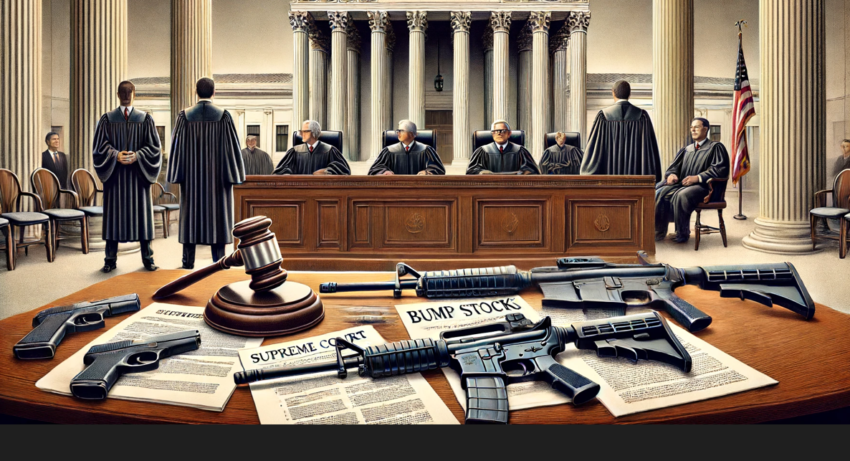| Listen to our audio presentation: Global Nuclear Proliferation |
On June 14, 2024, the United States Supreme Court delivered a significant ruling in the case of Garland, Attorney General, et al. v. Cargill, concerning the classification of bump stocks under federal law. The Court held that the Bureau of Alcohol, Tobacco, Firearms and Explosives (ATF) exceeded its statutory authority by issuing a rule that classifies bump stocks as “machineguns” under the National Firearms Act (NFA).
Background
The case centers on the definition of a “machinegun” as per the National Firearms Act of 1934, which includes any weapon that “shoots, is designed to shoot, or can be readily restored to shoot, automatically more than one shot, without manual reloading, by a single function of the trigger” (26 U.S.C. §5845(b)). This classification also encompasses any device that converts a weapon into a machinegun.
Bump stocks, which became a focal point after their use in the 2017 Las Vegas shooting, are attachments that enable semiautomatic rifles to fire at rates similar to fully automatic weapons by using the firearm’s recoil to reset and reengage the trigger rapidly. Following the tragedy, the ATF issued a rule in 2018 reclassifying bump stocks as machineguns, requiring their destruction or surrender.
Supreme Court’s Decision
The Supreme Court’s majority opinion, delivered by Justice Thomas, found that the ATF’s rule was beyond its statutory authority. The Court’s analysis hinged on two primary points:
Trigger Functionality: The Court concluded that a semiautomatic rifle equipped with a bump stock does not fire more than one shot “by a single function of the trigger.” Each shot requires the trigger to be released and reengaged, even if this process happens rapidly. Therefore, the bump stock does not convert the semiautomatic weapon into a machinegun as defined by the NFA.
Automatic Firing: The Court also determined that even if a bump stock allows multiple shots with a single function of the trigger, it does not do so “automatically.” For a weapon to be classified as a machinegun, the ability to fire multiple shots must be caused automatically by the trigger function alone, without any additional manual input from the shooter. Bump stocks require the shooter to maintain forward pressure on the weapon, distinguishing them from automatic firearms, which continue firing as long as the trigger is held down.
Concurring and Dissenting Opinions
Justice Alito, in his concurring opinion, emphasized the clarity of the statutory text and the need for Congress to amend the law if bump stocks are to be banned. He highlighted that the tragic events, such as the Las Vegas shooting, underscore the necessity for legislative action rather than administrative reinterpretation.
In a dissenting opinion, Justice Sotomayor, joined by Justices Kagan and Jackson, argued that the majority’s interpretation undermines the statute’s intent to restrict access to firearms capable of rapid, sustained fire. She contended that the term “single function of the trigger” should encompass the practical reality of how bump stocks facilitate continuous firing with minimal input from the shooter.
Implications
The ruling has significant implications for gun regulation in the United States. It reinforces the limitations on administrative agencies like the ATF in expanding the scope of existing firearm laws without clear congressional authorization. This decision may prompt legislative bodies to revisit and possibly amend the definitions and regulations concerning firearm accessories like bump stocks to address public safety concerns more explicitly.
Conclusion
The Supreme Court’s decision in Garland v. Cargill marks a pivotal moment in the ongoing debate over gun control and the interpretation of firearm regulations. It underscores the necessity for precise statutory language and legislative clarity to address evolving technologies in firearms and their accessories.
Resources
Supreme Court of the United States. Garland, Attorney General, et al. v. Cargill, No. 22-976. Decided June 14, 2024.
National Firearms Act of 1934, 26 U.S.C. §5845(b).
Bureau of Alcohol, Tobacco, Firearms and Explosives, Rule 83 Fed. Reg. 66514 (2018).

